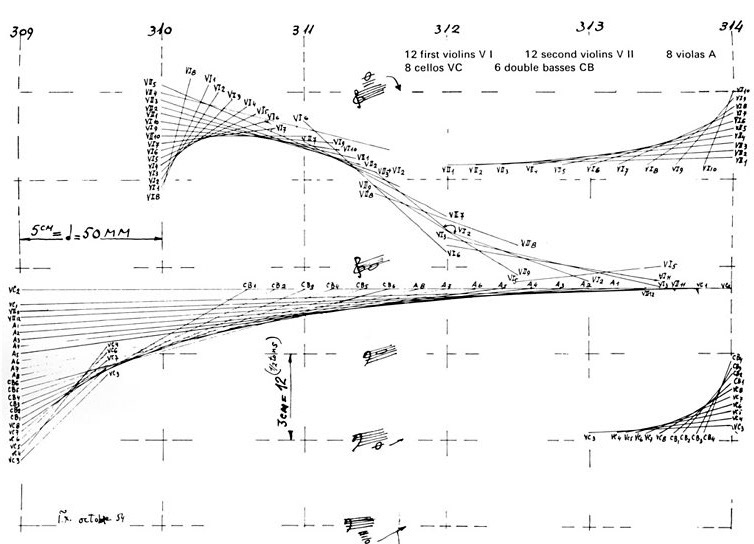Iannis Xenakis.
Iannis Xenakis was an architect, music theorist and mathematician who composed scores with the aid of computing. He studied under Olivier Messiaen who was well known for his compositions mainly for chamber music and piano. He encouraged Xenakis to utilise his special skills that were unique only to him and create pieces that were out of the norms. His works were extensively centered around mathematical formulas and procedures that allowed him to derive musical forms and detailing.
Metastasis.
This piece was later acknowledged as Xenakis’ first mature composition. The piece utilises draftsmen geometrical procedures seen in the field of architecture to derive music forms. He notated pitch ranges between special dimensions as well as measured auditory dimensions in regards to time versus pitch.
His works in general have a very practical foundation. Though musically it was considered abstract, the logical reasoning in the composition procedure was very methodological.
If a building was built upon a succession of bricks, his aim would be to compose the piece so that each individual note is undeniable in perfect succession which in this case could only be achieved by a glissando. The stacking of bricks and other layers would be intensified in parallel to the structure he was modelling and the music he was composing.
Iannis Xenakis has been known to utilise mathematics and engineering methods across most if not all his works. Seldom would his works not carry a wide array of mathematical scripting. He has used various well known mathematical theories such as einstein’s Theory of time, algebraic equations and the Fibonacci.

Metastasis score.

One of the more well known sketches he made on this project out of the many extensive pieces. In this sketch, he has monitored numbers and pitch in between two intersecting spacial dimensions. This sketch in particular was directed at the use of glissandos in order to achieve an unbroken and continuing sound.
Frequencies in UTS cityscape.
This work is aimed to translate dimensions into frequencies.
From documenting as many angles of buildings and infrastructure of the UTS campus skyline, the angles were then taken as frequencies and translated from hertz to a pitch or the closest musical relative note.


Work in progress. An experimentation of mathematical formulas and their visual representations. By mapping out the angles of appreciation and depreciation on the UTs campus landscape, these angles were translated as rough scales of frequency. Using the formula on the top right, the frequencies were assigned their closest pitch note and translated into a musical language. The process is shown on the right side of the image.

Due to the overlapping of infrastructure and therefore angles, there were several chords present in the piece as opposed to single notes.
The angles that were converted to pitch was roughly translated to the closest note dependant on the frequency of 440 Hertz which is the concert pitch note A4. The audio was played on the piano. Rests、dotted notes and ghosts notes were played accordingly as parallel to the breaks on the drawing.
References:
Iannis Xenakis in Peter Hoffman, ‘Xenakis, Iannis’, , Oxford Music Online, <http://www.oxfordmusiconline.com/subscriber/article/grove/music/30654>> viewed 10 September 2019.
Iannis Xenakis in Balint Andras Varga, , London, Fabre and Fabre 1996, 72.
